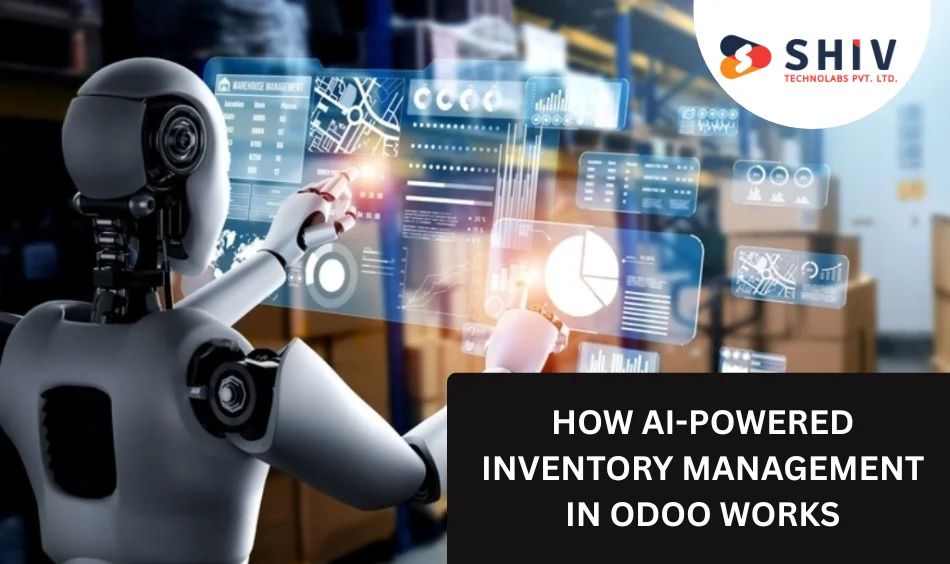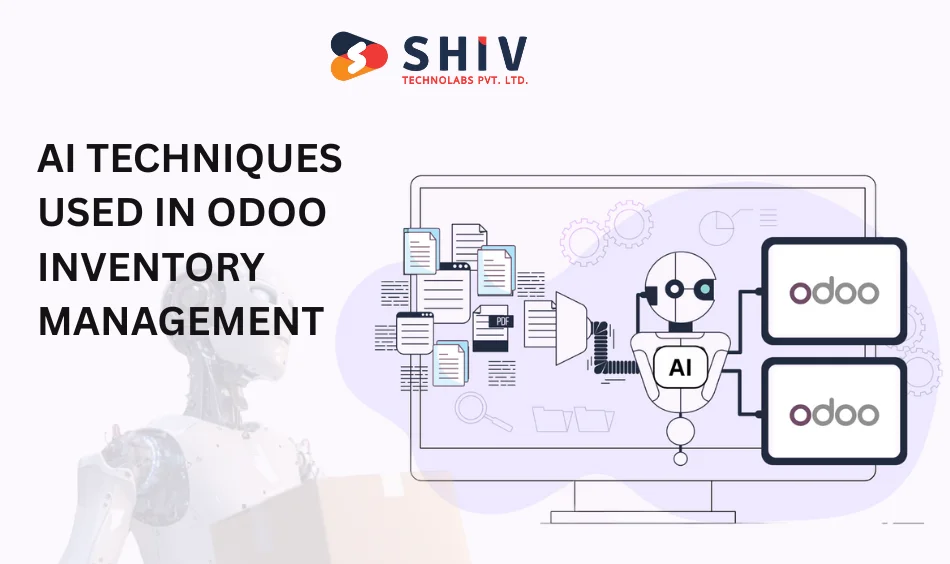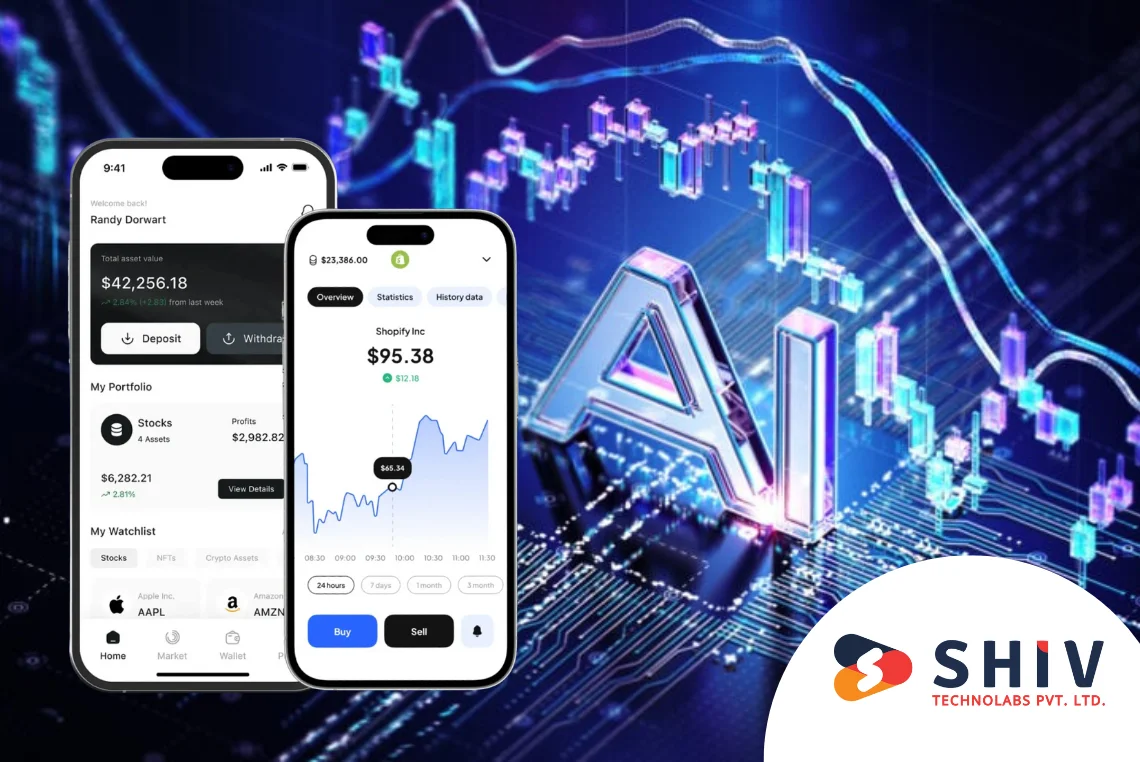Table of Contents
AI-based inventory management combines artificial intelligence and conventional stock handling to produce wiser and more efficient supply chain operations. AI overhauls companies’ forecasting, planning, and inventory optimization processes by implementing Odoo ERP. These technologies enable companies to lower their cost, become more accurate, and make their whole inventory process smoother.
How AI-Powered Inventory Management in Odoo Works

Odoo AI stock management uses machine learning and computer algorithms to utilize past data, forecast future demand, and provide autonomous replenishment decisions for inventory.
Odoo ERP and Machine learning inventory optimization Odoo can use AI-driven inbuilt algorithms to utilize the history of sales, seasonality, and market patterns to create highly accurate forecasts of demand. The forecast feature is used to bridge the difference between reactive stock management and proactive future planning.
The system integrates the basic inventory feature of Odoo with artificial intelligence-based analytics for designing intelligent workflows, which are capable of responding and adapting sensibly to changing business environments.
Machine learning algorithmic solutions implemented within Odoo ERP are a great combination, rendering it easy to analyze collected data.
Greatest Advantages of AI-Based Inventory Management
Here are the listed benefits of AI-powered Inventory Management systems that reduce cost, errors, inaccurate predictions and enhance customer satisfaction.
Improved Accuracy and Reduced Cost
Companies that utilized AI and automation minimized the inventory cost by 25% because they could plan demand better, in addition to managing stocks in real time. AI does not involve human mistakes in demand planning, and it synchronizes stocks to avoid overstocking as well as stockout.
AI Benefits Comparison Table
Key points based on the classification:
| Traditional Inventory | AI-Powered Inventory | Improvement |
|---|---|---|
| Manual demand forecasting | Machine learning predictions | 90% accuracy rate |
| Fixed reorder points | Dynamic replenishment rules | 25% cost reduction |
| Reactive stock management | Predictive analytics | 65% lower stockouts |
| Manual data entry | Automated barcode processing (Odoo barcode inventory AI) | 80% less error |
Improved Customer Satisfaction
Inventory management through predictive analytics using artificial intelligence has lowered stockouts by as much as 65%, and products can be restocked whenever the customer wants them. Such reliability has a direct impact on enhanced customer satisfaction and loyalty.
Strategic Business Intelligence
Odoo ERP’s analytics engine is based on machine learning processes, humongous data, and extrapolating trends and patterns to serve as the business house benchmark for demand planning, stock optimization, and strategic business decision-making.
AI Techniques Used in Odoo Inventory Management

These techniques can foster real-time optimization, forecasting and reliability in Odoo inventory management:
Machine Learning-based Demand Forecasting
- History analysis – AI reads past sales history and identifies trends and patterns that may not otherwise be readily perceivable by human experts to find
- Seasonal Adjustments – Algos inherently account for seasonality, holidays, and cycles of the market
- External Factor Integration – Weather patterns, economic forecasts, and industry trends are integrated into the system
Smart Replenishment Rules in Odoo
Dynamic Reorder Points – Artificial intelligence determines dynamic minimum stock levels by considering:
- Uncertainty in lead times
- Variability in demand
- Supplier reliability
- Seasonal factors
Automated Buy Recommendations – Artificial intelligence determines reorder points and automatically triggers purchase orders when inventories drop to them
Real-time Inventory Optimization
- Analysis Automation – AI categorizes inventory items and modifies management strategies accordingly
- Dead Stock Prevention – AI detects slow-moving stock even prior to becoming dead stock
- Multi-Location Stock Balancing – AI balancing stock across multiple warehouses and locations
Implementation Guide: Implementing AI in Odoo Inventory
Implementation of AI in the Odoo inventory goes through a lot of phases like:
Step 1: Data Preparation
- Clean Historical Data – Keep a minimum 12-month sales history to get a good forecast
- Standardize Product Details – Same product groups and SKU numbers
- Configure Inventory Settings – Define lead times, safety stock quantities, and reorder strategies
Step 2: AI Module Setup
Install Forecasting Modules (Odoo AI inventory forecasting)
- Configure Odoo Apps Store and install AI inventory forecasting modules
- Configure machine learning settings according to business needs
- Configure automatic data synchronization between the sales and inventory modules
Configure Smart Rules
- Configure reorder points according to AI suggestions
- Utilize automated generation of purchase orders
- Create exception handling for outlier patterns of demand
Step 3: Training and Calibration
- Initial Training Phase – Give 2-4 weeks to AI models to get trained on your trend data
- Accuracy Checking – Continuously check forecast accuracy and tweak parameters if needed
- Ongoing Improvement – Give continuous checks and tweak AI forecasts according to reality
Use Cases and Applications
AI in manufacturing supply chain has benefits ranging from automation, reduction of cost, defect detection and defect detection strategies and here’s how it is used:
Supply Chain Manufacturing
- Production Planning – AI predictive demand modules within Odoo ERP automate order creation for production based on forecasted demands
- Raw Material Optimization – AI calculates the material needed and guides delivery to minimize carrying costs
- Quality Control Integration – machine learning detects trends in pattern defects and resizes buffers of inventory
Retail and E-commerce
- Seasonal Demand Management – AI governs holiday season, promotion, and market event levels of inventory
- Multi-Channel Optimization – Algos optimizes stock in offline and digital channels
- Customer Behavior Analysis – AI monitors purchases to predict future orders
Distribution and Wholesale
- Supplier Performance Optimization – AI monitors supplier reliability and strategy-adjusts for safety stock (Odoo distribution management system)
- Route Optimization – Machine learning maps the best routes and inventory distribution
- Risk Management – AI estimates likely supply chain disruptions and creates backup plans
Best Practices for AI Inventory Success
In an AI-powered inventory management, techniques and strategies like Machine learning inventory optimization Odoo and AI in manufacturing supply chain can give promising results and these practices can be listed as:
Data Quality Management
- Periodic Data Audits – Validate inventory data integrity every month
- Standardized Processes – Single data entry process per department
- Integration Testing – Regularly test data integration across various Odoo modules
Performance Monitoring
- Key Metrics Tracking – Keep track of forecast accuracy, stock turnover, and service level
- Exception Reporting – Produce exception patterns or system anomaly alerts
- Continuous Optimization – Review and readjust AI parameters at regular intervals
User Training Programs
Educate staff on AI suggestions and override mechanisms
- Change Management – Gradually introduce AI capability to allow accommodation by the team
- Feedback Loops – Enable users to report and provide feedback to other users
Advanced Features and Future Functionality
The future of AI in Odoo inventory management and Odoo distribution management system is evolving and here are some advanced features and functionalities that can contribute:
Predictive Maintenance Integration
Predictive maintenance with AI allows inventory management hardware to be serviced before failure, avoiding system downtime and business continuity.
IoT Sensor Integration
Smart sensors provide instant inventory data utilized by AI to determine instant stock level and reorder point decisions.
Blockchain Traceability
Artificial intelligence with blockchain technology provides end-to-end traceability along the supply chain and real-time reporting of compliance.
Conclusion
Odoo AI-driven inventory management is a major leap towards supply chain accuracy and efficiency using inventory forecasting with AI in Odoo, which can contribute $1.3 trillion to the global economy in the coming two decades if utilized correctly for supply chain and logistics management.
We, Shiv Technolabs are embracing such technologies like AI in manufacturing supply chain to build competitive edges through cost savings, enhanced customer satisfaction, and decision-making acumen that fuel business growth.
The success formula lies in well-managed AI capabilities, real-time visibility, and phased deployment. Through compliance with the principles of thumb and best practices outlined in this guidebook, organizations can revolutionize their inventory management to be the cost driver of operational excellence and customer delight.























